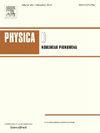光学湍流中的束缚态吸引子
IF 2.7
3区 数学
Q1 MATHEMATICS, APPLIED
引用次数: 0
摘要
我们在一个与光学系统的实际建模相关的空间非局部非线性Schrödinger方程中研究相干、孤子、非线性波的不可积动力学:Schrödinger-Helmholtz方程。我们观察到一个单一的振荡,相干孤立波出现从各种初始条件。利用(可积)三次非线性Schrödinger方程的直接散射变换,我们发现该结构是一个束缚态,由一个主孤子和一个次孤子组成,它们的振幅呈相位相反的振荡。我们把这解释为孤子周期性地交换质量。我们还观察到由三个振荡孤子组成的束缚态,暗示了多孤子束缚态家族的存在。聚焦于双孤子束缚态,我们观察到它从非相干湍流的初始状态和从发射到系统中的孤子结构的自组织。当单个(主)孤子结构被发射时,它与系统中的波之间的共振过程产生二次孤子,从而产生束缚态。此外,当两个孤子最初发射时,我们证明如果它们的相位在碰撞时同步,它们可以合并。当系统从由许多初始孤子组成的湍流状态发射时,我们提出在束缚态形成之前有一系列的二元碰撞,其中质量平均从弱孤子转移到强孤子,偶尔有孤子合并。这两个过程都会导致越来越强的孤子和越来越少的主导孤子。最终态——一个被弱非线性波包围的孤立束缚态——是强健且普遍存在的。我们提出,对于非局部介质,由至少两个孤子组成的束缚态是比以往文献中提出的单孤子吸引子更典型的统计吸引子。本文章由计算机程序翻译,如有差异,请以英文原文为准。
A bound state attractor in optical turbulence
We study numerically the nonintegrable dynamics of coherent, solitonic, nonlinear waves, in a spatially nonlocal nonlinear Schrödinger equation relevant to realistic modelling of optical systems: the Schrödinger–Helmholtz equation. We observe a single oscillating, coherent solitary wave emerging from a variety of initial conditions. Using the direct scattering transform of the (integrable) cubic nonlinear Schrödinger equation, we find that this structure is a bound state, comprising of a primary and secondary soliton whose amplitudes oscillate in phase opposition. We interpret this as the solitons periodically exchanging mass. We also observe bound states comprising of three oscillating solitons, hinting at the existence of a family of multi-soliton bound states. Focusing on the two-soliton bound state, we observe it self-organising from an initial state of incoherent turbulence, and from solitonic structures launched into the system. When a single (primary) solitonic structure is launched, a resonance process between it and waves in the system generates the secondary soliton, resulting in the bound state. Further, when two solitons are initially launched, we show that they can merge if their phases are synchronised when they collide. When the system is launched from a turbulent state comprised of many initial solitons, we propose that the bound state formation is preceded by a sequence of binary collisions, in which the mass is transferred on average from the weak soliton to the strong one, with occasional soliton mergers. Both processes lead to increasingly stronger and fewer dominant solitons. The final state – a solitary bound state surrounded by weakly nonlinear waves – is robust and ubiquitous. We propose that for nonlocal media, a bound state comprising of at least two solitons is a more typical statistical attractor than the single-soliton attractor suggested in previous literature.
求助全文
通过发布文献求助,成功后即可免费获取论文全文。
去求助
来源期刊

Physica D: Nonlinear Phenomena
物理-物理:数学物理
CiteScore
7.30
自引率
7.50%
发文量
213
审稿时长
65 days
期刊介绍:
Physica D (Nonlinear Phenomena) publishes research and review articles reporting on experimental and theoretical works, techniques and ideas that advance the understanding of nonlinear phenomena. Topics encompass wave motion in physical, chemical and biological systems; physical or biological phenomena governed by nonlinear field equations, including hydrodynamics and turbulence; pattern formation and cooperative phenomena; instability, bifurcations, chaos, and space-time disorder; integrable/Hamiltonian systems; asymptotic analysis and, more generally, mathematical methods for nonlinear systems.
 求助内容:
求助内容: 应助结果提醒方式:
应助结果提醒方式:


